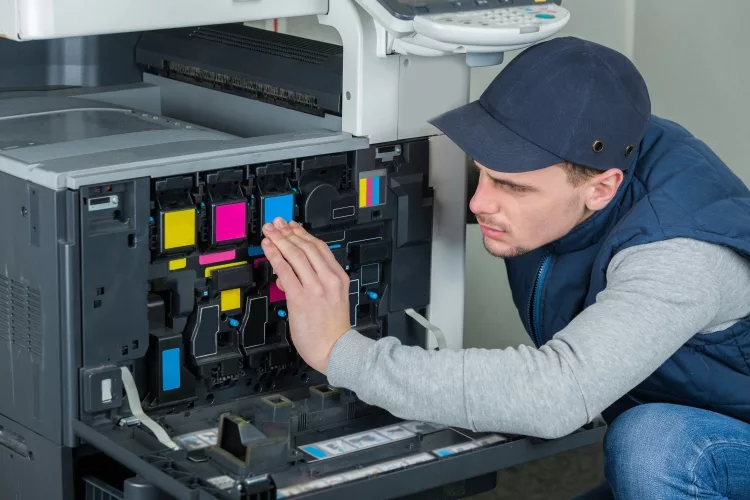Choosing the right kind of ink for your inkjet printer is an important decision.
In today's article, we will explain the differences between dye ink and pigment ink so that you know the ups and downs of choosing either.
Contents
Expert Tips for Dye Ink vs Pigment Ink
There are many factors to consider when choosing between dye ink and pigment ink for your printing needs. Here are a few expert tips to help you make the best decision for your project:
- Consider the type of project you're printing. Dye inks are ideal for general printing projects like flyers or brochures, while pigment inks are better suited for high-quality prints like photos or artwork.
- Think about the paper you'll be using. Dye inks generally provide better coverage on glossy papers, while pigment inks tend to work better on matte or coated papers.
- Keep fading in mind. Dye inks can fade over time, especially when exposed to sunlight, so they may not be the best choice for prints that you want to last. Pigment inks are much more fade-resistant, making them a better option for long-term projects.
- Consider your budget. Dye inks are typically less expensive than pigment inks, so if cost is a factor, they may be the better option.
- Test out both types of inks before making your final decision. Ultimately, the best way to decide which type of ink is right for you is to experiment with both and see which provides the results you're looking for.
When it comes to dye ink vs pigment ink, there is no one-size-fits-all answer. The best way to choose is to consider the specific needs of your project and then test out both types of inks to see which works best for you.
Difference Between Dye Ink and Pigment Ink in Detail

1. Particle Size
In dye inks, the size of each ink particle is 4 nanometers - smaller than the size of human hair.
Meanwhile, the size of an ink particle in pigment ink is 0.05 to 0.20 micrometers, which can be almost the size of human hair.
The smaller ink particles indye inkhelp them seep inside the white paper producing a better printout.
The larger ink particle size of pigment ink makes it hard for the particle to seep inside the paper, producing only a certain range of colors in the printout. Some colors look less bright and muted, especially the color red.
However, using an inkjet receptor coat on your paper can produce a better printout when using pigment ink. But using this special top coating on your paper means higher printing costs.
2. Impact Of Water
The ink particles in dye ink can be dissolved in water and other liquids, just like salt and sugar.
Since the ink particles are soluble in water, the printout can be spoiled immediately if the paper comes in contact with any water droplet. Some paper types come with specially coated material, which makes the paper water-resistant. But purchasing this paper increases your printing costs.
By contrast with pigment inks, the ink particles behave as if one is attempting to dissolve sand in water, which can't be done, thus creating a suspension.
3. Impact Of Light
Dye ink refracts very little sunlight. Hence, the printout looks bright, and a wider range of colors is displayed.
However, exposure to sunlight can also fade the dye ink colors after printing and eventually ruin the image. Therefore, dye inks are mostly recommended for indoor use.
Note: Recently, a special type of dye ink has been released called UV dye ink. This new dye ink is resistant to the UV rays of sunlight, keeping the printout looking fresherrather than fading over time.
Unlike dye inks, pigment inks are water-resistant and UV-resistant, meaning that exposure to sunlight won't change the quality of the printout. Theoretically, you can keep your printouts outdoors for two years, seeing no change in the quality.
4. Color
Colors might pop out more when dye inks are used, but pigment inks have a more solid black ink than dye ink. For this reason, you see higher-end printers have two separate black inks - one dye and one pigment.
When blackdye ink is mixed with water, purple color is produced. But when the black pigment ink is mixed with water, the color stays black.
Storing The Ink
Storing pigment ink doesn't require any special precautions to be taken.
However, for dye inks, ensure that the print head is stored with an airtight seal, as you'd find on some kitchen containers. Dye inks are water-based - when they get dry, they are ruined. Air will dry them out quickly, which is why airtight storage is required.
Which Ink Should I Use Between Dye Ink and Pigment Ink ?
If you are using a desktop printer at home, then the choice of ink is not that critical. However, if you are using a professional printing service, then the type of ink can make a big difference in the final product.
Dye ink is the traditional ink used for printing and it has been around for centuries. It is made from colorants that are dissolved in a liquid carrier. The advantage of dye ink is that it dries quickly and it produces vibrant colors. However, the disadvantage is that it can fade over time and it is not waterproof.
Pigment ink is a newer technology that was developed in the 1980s. It uses tiny particles of pigment suspended in a liquid carrier. The advantage of pigment ink is that it is very resistant to fading and it is waterproof. However, the disadvantage is that it takes longer to dry and the colors are not as vibrant as dye ink.
So, which ink should you use? It really depends on what you are going to use the printouts for. If you need prints that will last a long time and will not fade, then pigment ink is the way to go. However, if you need prints that will be used soon after they are printed and you don't mind if the colors are not as vibrant, then dye ink is probably fine.
Conclusion for Pigment Ink vs Dye Ink
Pigment ink and dye ink are two of the most popular types of inks used in printers. Each has its own advantages and disadvantages. Pigment ink is generally more expensive, but it is more fade-resistant and produces sharper images. Dye ink is less expensive, but it can fade over time and does not produce as sharp of an image. Ultimately, the decision of which type of ink to use depends on your specific needs and preferences.
Related posts:




